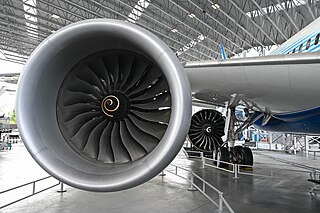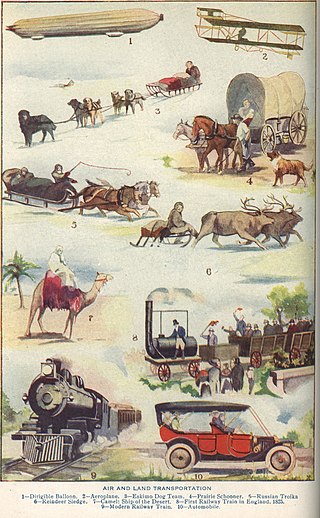Conversion of units is the conversion between different units of measurement for the same quantity, typically through multiplicative conversion factors which change the measured quantity value without changing its effects. Unit conversion is often easier within the metric or the SI than in others, due to the regular 10-base in all units and the prefixes that increase or decrease by 3 powers of 10 at a time.

Ton is the name of any one of several units of measure. It has a long history and has acquired several meanings and uses.
Specific impulse is a measure of how efficiently a reaction mass engine creates thrust. For engines whose reaction mass is only the fuel they carry, specific impulse is exactly proportional to the effective exhaust gas velocity.

The turbofan or fanjet is a type of airbreathing jet engine that is widely used in aircraft propulsion. The word "turbofan" is a combination of the preceding generation engine technology of the turbojet, and a reference to the additional fan stage added. It consists of a gas turbine engine which achieves mechanical energy from combustion, and a ducted fan that uses the mechanical energy from the gas turbine to force air rearwards. Thus, whereas all the air taken in by a turbojet passes through the combustion chamber and turbines, in a turbofan some of that air bypasses these components. A turbofan thus can be thought of as a turbojet being used to drive a ducted fan, with both of these contributing to the thrust.
Thrust-specific fuel consumption (TSFC) is the fuel efficiency of an engine design with respect to thrust output. TSFC may also be thought of as fuel consumption (grams/second) per unit of thrust, hence thrust-specific. This figure is inversely proportional to specific impulse, which is the amount of thrust produced per unit fuel consumed.

A kilowatt-hour is a non-SI unit of energy equal to 3.6 megajoules (MJ) in SI units which is the energy delivered by one kilowatt of power for one hour. Kilowatt-hours are a common billing unit for electrical energy supplied by electric utilities. Metric prefixes are used for multiples and submultiples of the basic unit, the watt-hour.
The heating value of a substance, usually a fuel or food, is the amount of heat released during the combustion of a specified amount of it.

Jet propulsion is the propulsion of an object in one direction, produced by ejecting a jet of fluid in the opposite direction. By Newton's third law, the moving body is propelled in the opposite direction to the jet. Reaction engines operating on the principle of jet propulsion include the jet engine used for aircraft propulsion, the pump-jet used for marine propulsion, and the rocket engine and plasma thruster used for spacecraft propulsion. Underwater jet propulsion is also used by several marine animals, including cephalopods and salps, with the flying squid even displaying the only known instance of jet-powered aerial flight in the animal kingdom.

Hydraulic head or piezometric head is a specific measurement of liquid pressure above a vertical datum.
Specific energy or massic energy is energy per unit mass. It is also sometimes called gravimetric energy density, which is not to be confused with energy density, which is defined as energy per unit volume. It is used to quantify, for example, stored heat and other thermodynamic properties of substances such as specific internal energy, specific enthalpy, specific Gibbs free energy, and specific Helmholtz free energy. It may also be used for the kinetic energy or potential energy of a body. Specific energy is an intensive property, whereas energy and mass are extensive properties.

The JetTrain was an experimental high-speed passenger train concept created by Bombardier Transportation in an attempt to make European-style high-speed service more financially appealing to passenger railways throughout North America. It was designed to use the same LRC-derived tilting carriages as the Acela Express trains that Bombardier built for Amtrak in the 1990s, which used all-electric locomotives. Unlike the Acela, powered electrically by overhead lines, the JetTrain would have used a combination of a 4,000-horsepower (3.0 MW) gas-turbine engine, a low-power diesel engine, a reduction gearbox, and two alternators to power electric traction motors. This would have allowed it to run at high speeds on non-electrified lines.
In aerospace engineering, concerning aircraft, rocket and spacecraft design, overall propulsion system efficiency is the efficiency with which the energy contained in a vehicle's fuel is converted into kinetic energy of the vehicle, to accelerate it, or to replace losses due to aerodynamic drag or gravity. Mathematically, it is represented as , where is the cycle efficiency and is the propulsive efficiency.
The energy content of biofuel is the chemical energy contained in a given biofuel, measured per unit mass of that fuel, as specific energy, or per unit of volume of the fuel, as energy density. A biofuel is a fuel produced from recently living organisms. Biofuels include bioethanol, an alcohol made by fermentation—often used as a gasoline additive, and biodiesel, which is usually used as a diesel additive. Specific energy is energy per unit mass, which is used to describe the chemical energy content of a fuel, expressed in SI units as joule per kilogram (J/kg) or equivalent units. Energy density is the amount of chemical energy per unit volume of the fuel, expressed in SI units as joule per litre (J/L) or equivalent units.

The energy efficiency in transport is the useful travelled distance, of passengers, goods or any type of load; divided by the total energy put into the transport propulsion means. The energy input might be rendered in several different types depending on the type of propulsion, and normally such energy is presented in liquid fuels, electrical energy or food energy. The energy efficiency is also occasionally known as energy intensity. The inverse of the energy efficiency in transport, is the energy consumption in transport.
The units of measurement in transportation describes the unit of measurement used to express various transportation quantities, as used in statistics, planning, and their related applications.
The Glossary of fuel cell terms lists the definitions of many terms used within the fuel cell industry. The terms in this fuel cell glossary may be used by fuel cell industry associations, in education material and fuel cell codes and standards to name but a few.

The Power Jets W.1 was a British turbojet engine designed by Frank Whittle and Power Jets. The W.1 was built under contract by British Thomson-Houston (BTH) in the early 1940s. It is notable for being the first British jet engine to fly, as the "Whittle Supercharger Type W1", powering the Gloster E.28/39 on its maiden flight at RAF Cranwell on 15 May 1941. The W.1 was superseded by the Power Jets W.2.

Motorcycle testing and measurement includes a range of more than two dozen statistics giving the specifications of the motorcycle, and the actual performance, expressed by such things as the output of the engine, and the top speed or acceleration of the motorcycle. Most parameters are uncontroversial and claims made by manufacturers are generally accepted without verification. These might include simple measurements like rake, trail, or wheelbase, or basic features, such as the type of brakes or ignition system.
Brake-specific fuel consumption (BSFC) is a measure of the fuel efficiency of any prime mover that burns fuel and produces rotational, or shaft power. It is typically used for comparing the efficiency of internal combustion engines with a shaft output.








